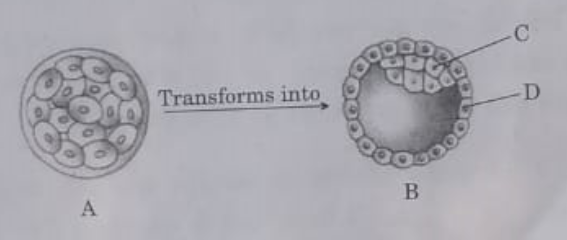Name the embryonic stage that gets implanted in the uterine wall of a human female.
To answer the question, "Name the embryonic stage that gets implanted in the uterine wall of a human female," we can follow these steps:
1. Understanding Fertilization:
- Fertilization occurs when the male gamete (sperm) fuses with the female gamete (egg) to form a diploid cell called the zygote.
2. Location of Fertilization:
- In humans, fertilization typically occurs in the fallopian tube, specifically at the ampullary-isthmic junction.
3. Zygote Development:
- After fertilization, the zygote begins to divide through a process called cleavage, resulting in multiple cells. This process continues as the zygote moves towards the uterus.
4. Formation of Morula:
- As the zygote divides, it reaches an 8 to 16 cell stage known as the morula. This stage occurs while the embryo is still traveling to the uterus.
5. Development into Blastocyst:
- Once the morula reaches the uterus, it continues to divide and develops into a blastocyst. The blastocyst has two distinct parts: an outer layer of cells called the trophoblast and an inner cell mass.
6. Implantation Process:
- The blastocyst then attaches itself to the endometrial wall of the uterus. This attachment is known as implantation, which is crucial for establishing pregnancy.
7. Conclusion:
- The embryonic stage that gets implanted in the uterine wall is the blastocyst.
Final Answer:
The embryonic stage that gets implanted in the uterine wall of a human female is the blastocyst.
---
- Fertilization occurs when the male gamete (sperm) fuses with the female gamete (egg) to form a diploid cell called the zygote.
- In humans, fertilization typically occurs in the fallopian tube, specifically at the ampullary-isthmic junction.
- After fertilization, the zygote begins to divide through a process called cleavage, resulting in multiple cells. This process continues as the zygote moves towards the uterus.
- As the zygote divides, it reaches an 8 to 16 cell stage known as the morula. This stage occurs while the embryo is still traveling to the uterus.
- Once the morula reaches the uterus, it continues to divide and develops into a blastocyst. The blastocyst has two distinct parts: an outer layer of cells called the trophoblast and an inner cell mass.
- The blastocyst then attaches itself to the endometrial wall of the uterus. This attachment is known as implantation, which is crucial for establishing pregnancy.
- The embryonic stage that gets implanted in the uterine wall is the blastocyst.
The embryonic stage that gets implanted in the uterine wall of a human female is the blastocyst.
Similar Questions
Knowledge Check
- Question 1 - Select One
Gastrula is the embryonic stage in which
Acleavage occursBblatocoel formCgerminal layersDvilliform.
Early embryonic stage that follows blastula is
View SolutionStudy the given diagram: A is an embryonic stage that gets transformed into B, which in turn gets implanted in the endometrium in human females.

(a) Identify A, B and its parts C and D.
(b) Stage the fate of C and D in the course of embryonic development in humans.View SolutionClitoris in a human female is
View SolutionDescribe oogenesis in human female.
View SolutionName the stage of human embryo at which it gets implanted. Explain the process of implantation.
View SolutionAt what stage is mammalian embryo implanted in the uterus?
View SolutionOogenesis in a human female starts
View Solution

